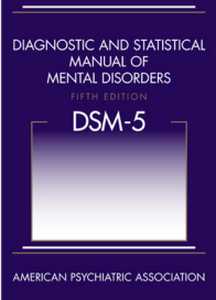

MedFriendly®


Diagnostic and Statistical Manual of Mental Disorders (DSM)
The Diagnostic and Statistical Manual of Mental
Disorders (commonly abbreviated as DSM) is a book
published by the American Psychiatric Association, that
is used to officially diagnose mental disorders.
WHAT IS THE MOST CURRENT EDITION OF THE
DSM?
The most current edition (published in 2013) of the DSM
is the DSM-5. This stands for the DSM (5th edition)
Text Revision. The 4th edition was published in 1994
and was revised in 2000.
WHAT IS THE MULTIAXIAL CLASSIFICATION SYSTEM OF THE DSM?
When using the DSM-5 to diagnose a patient, clinicians evaluate the patient on five
separate axes, or branches of information, that are based on sets of criteria. This is
known as the multiaxial (more than one axis) classification system. Axis I and Axis II
include all of the mental disorders. Mental disorders diagnosed on Axis I are those that
cause the patient significant impairment and are the focus of the patient's treatment. The
exception is personality disorders and mental retardation, which are diagnosed on Axis II.
A person can have more than one diagnosis on Axis I. However, the diagnosis that is
listed first on Axis I should be the one that represents the patient's main area of difficulty.
"Where Medical Information is Easy to Understand"™
Diagnoses on Axis III are general medical conditions that are
potentially important in understanding or managing the patient's
mental disorder. An example of a diagnosis on Axis III would be
multiple sclerosis. Axis IV consists of stressors in the person's
environment or social setting that may affect the diagnosis,
treatment, and outlook of the patient's mental disorder. An example
would be death of a family member. Finally, Axis V is a rating given
by the clinician on a scale known as the Global Assessment of
Functioning (GAF). The score on the GAF indicates the patient's
overall level of functioning. Scores range from 1 to 100, with 100
being superior functioning. A score of 0 means that there was not
enough information to give an adequate score.
Keeping the above description in mind, here is an example of what a diagnosis may look like using the
DSM in a clinician's report:
AXIS I: Major Depressive Disorder
AXIS II: Dependent Personality Disorder
AXIS III: Mesothelioma
AXIS IV: Death of a family member
AXIS V: Current GAF: 60 (moderate symptoms).
IS THE DSM ALWAYS RIGHT?
No. A very important thing to keep in mind is that the criteria that are used to define mental disorders in
the DSM are based on a majority view of consultants and contributors in mental health care, many of
which are psychiatrists and some of which are psychologists. However, a majority view is not always
correct and the criteria used to diagnose mental disorders in one edition of the DSM are often changed in
future editions. Also, some mental disorders have been completely removed from the DSM. For example,
in 1973, homosexuality was removed from the DSM as a mental disorder.
WHAT ELSE IS IN THE DSM?
The DSM contains information about each mental disorder such as associated features of the disorder,
what age the disorder usually begins, whether the disorder is more likely to occur in males or females,
what types of impairments and complications are usually found in the disorder, what are risks for
developing the disorder, what patterns are found in the families of people with the mental disorder,
information on how to figure out the difference between similar mental disorders, the percent of people
that have the disorder, and more.
HOW MANY MENTAL DISORDERS ARE IN THE DSM?
There are over 300 mental disorders listed in the DSM-IV TR.
WHAT ARE THOSE CODE NUMBERS IN THE DSM?
Each mental disorder and physical disorder listed in the DSM is identified with a specific number. This
number matches those published by the World Health Organization's International Statistical Classification
of Diseases & Related Health Problems . This is commonly abbreviated and referred to as ICD. The ICD
is another classification system, used to classify mental and physical disorders. The most current version
is ICD-10.
WHAT ABOUT EARLIER EDITIONS OF THE DSM?
The original DSM was published in 1952 as a way to encourage clinicians to use the same standards to
diagnose mental illness and was partially based on the ICD-6 (6th edition). See the answer to the last
question for a description of ICD. The original DSM contained definitions of all named mental disorders but
did not list any criteria for diagnosing these disorders. The original DSM was influenced by the theories of
Sigmund Freud, but the names of many of the mental disorders had the word "reaction" after them, a term
used often by a psychologist named Adolf Meyer.
The DSM-II (2nd edition) was published in 1968. Freud's theories still influenced this edition, but the use of
the term "reaction" was dropped for the names of the mental disorders. Freud's theories were no longer a
major part of the DSM when the third edition (DSM-III) was published in 1980. The DSM-III was the first
time that clear criteria were stated in the DSM for diagnosing mental disorders. The DSM-III also saw the
introduction of the multi-axial classification system discussed above. Some clarifications and
improvements were published in a revised version of the third edition (DSM-III-R), published in 1987.
The DSM-IV was published in May on 1994. The major change in this edition is that it renamed a category
of mental disorders known as "Organic Mental Syndromes and Disorders" to "Delirium, Dementia, and
Amnestic and Other Cognitive Disorders." This change was made so that people did not assume that
disorders not listed in the category of "Organic Mental Syndromes and Disorders" were not due, at least in
part, to abnormal functioning of the brain or some other parts of the body (which is what the word "organic"
refers to).















